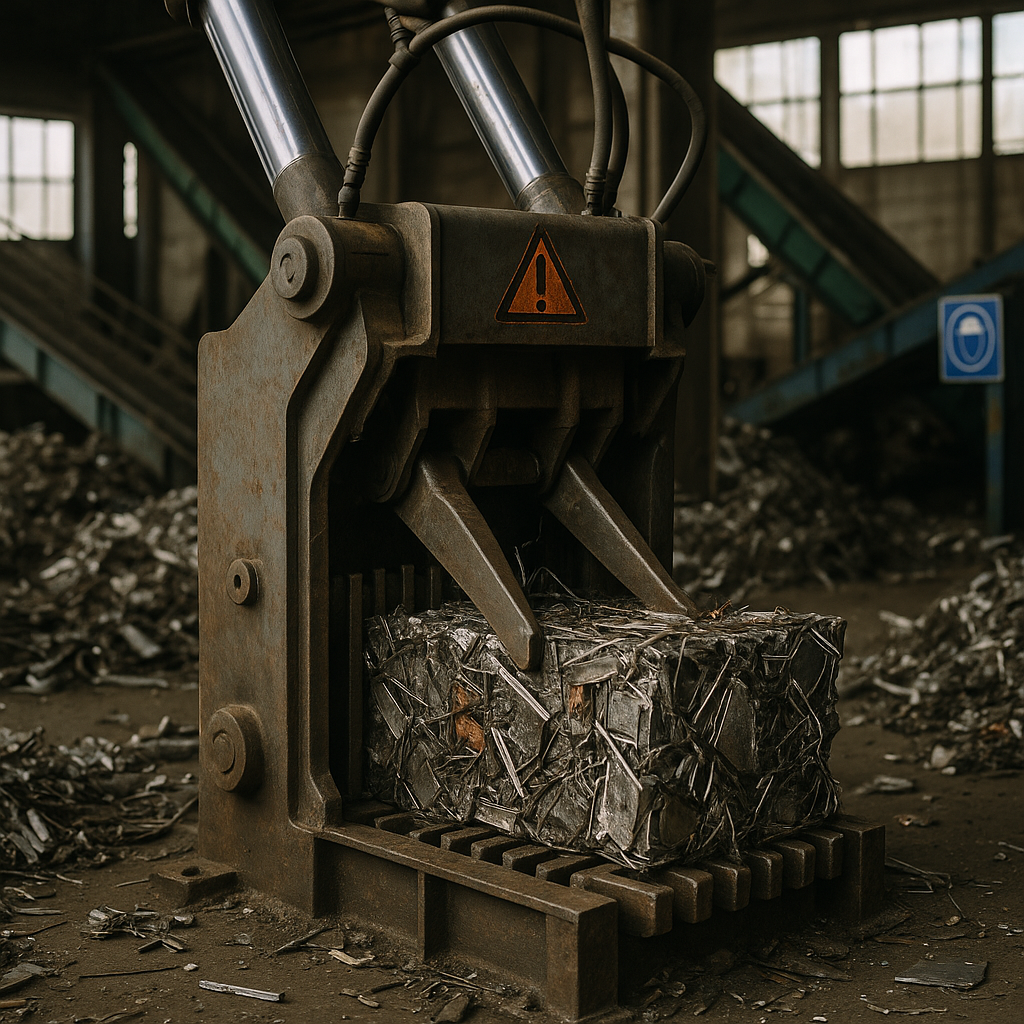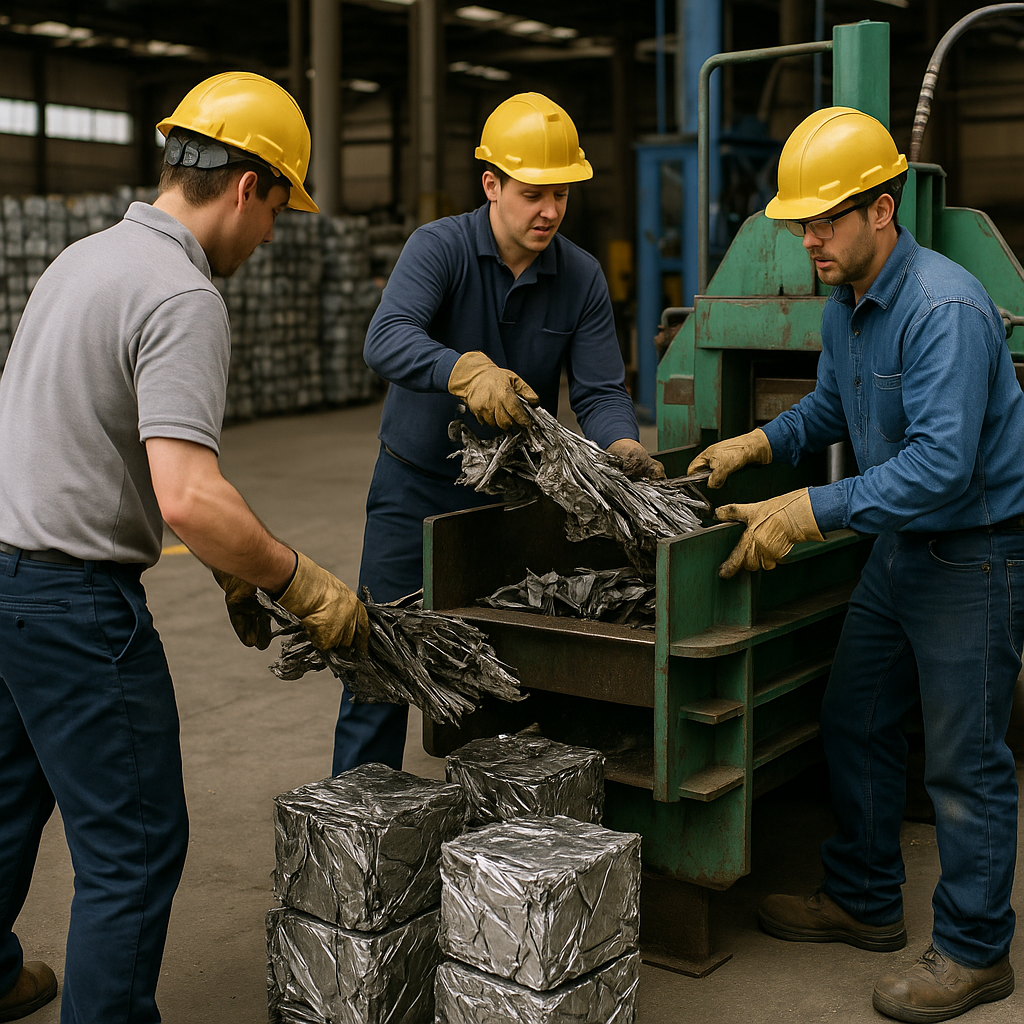5901 Botham Jean Blvd, Dallas, TX 75215
Metal Crushing and Baling: Process and Benefits
October 5, 2025Metal crushing and baling transform loose scrap metal into compact, uniform bundles using powerful machinery. This essential recycling process converts unwieldy metal waste into manageable packages that are easier to transport, store, and process. The technology applies tremendous force to compress metal from various sources into dense blocks or cylindrical forms.
At recycling facilities across the country, these specialized machines process tons of metal waste daily, handling everything from manufacturing scraps and construction debris to junked vehicles and discarded appliances. The compression significantly reduces the volume of metal waste, often by as much as 80 percent.
This process serves as a critical first step in the metal recycling chain. Without effective crushing and baling, recycling centers would struggle with storage limitations and inefficient transportation costs. The densely packed bales create a more economical pathway for scrap metal to return to production cycles rather than ending up in landfills.
How Do Metal Balers Work?

Metal balers transform loose scrap metal into dense, compact blocks through powerful hydraulic compression systems. These machines play a crucial role in the recycling industry by significantly reducing the volume of metal waste for more efficient storage and transport. The compression process follows specific steps to maximize density while ensuring operational safety.
The Hydraulic Compression System
At the heart of every metal baler is its hydraulic system. This system generates tremendous force by using hydraulic fluid under pressure to drive cylinders that power the compression mechanism. Modern balers can exert pressures of several thousand pounds per square inch, sufficient to compress even stubborn metal materials into dense blocks.
The hydraulic cylinders transform fluid pressure into mechanical force, driving the ram that compresses the metal. Most industrial balers utilize multiple cylinders working together to apply pressure from different angles, ensuring uniform compression throughout the bale.
The Step-by-Step Baling Process
- Material Loading – Operators load loose scrap metal into the baling chamber. This can be done manually for smaller operations or via conveyor systems and hoppers in larger recycling facilities.
- Chamber Closure – Once loaded, the chamber closes securely to contain the material during compression. Many modern balers feature safety interlocks that prevent operation until the chamber is fully closed.
- Initial Compression – The hydraulic system activates, driving the top cylinder to close the articulated door cover, forming the compression chamber that determines the height of the final bale.
- Main Compression – The main hydraulic ram extends, applying tremendous force to compress the metal. This stage reduces the volume of scrap metal by up to 90%, depending on the material type.
- Holding Pressure – Once maximum compression is achieved, the baler maintains pressure for several seconds to ensure the proper density and stability of the bale.
- Binding – Some systems automatically bind the compressed material with wire or straps to maintain its shape after ejection, while others require manual binding.
- Ejection – After compression and binding, the baler ejects the finished bale through a side door or ejection system.
Advanced Features in Modern Balers
Today’s metal balers incorporate sophisticated technology to improve efficiency, safety, and bale quality. Differential acceleration systems increase baling efficiency by optimizing hydraulic pressure throughout the compression cycle. Automatic cycling allows continuous operation without constant operator intervention.
Pressure monitoring systems ensure consistent bale density by maintaining precise hydraulic pressure levels. If pressure drops below set parameters, the system automatically adjusts to maintain optimal compression.
Operator safety remains paramount in baler design. Emergency stop buttons, safety guards, and interlocking systems prevent accidental operation when doors are open or personnel are in danger zones. Some models include remote monitoring capabilities, allowing operators to control the machine from a safe distance.
Different Bale Ejection Methods
Metal balers employ various ejection methods based on their design and the specific requirements of the recycling facility:
Side turning ejection rotates the bale 90 degrees out of the press box, producing bales with clean, sharp corners that stack efficiently. Forward-pushing systems move the bale straight out of the chamber, making them suitable for lighter materials. Side pushing ejection uses sliding tracks to move bales directly onto transport vehicles, reducing handling requirements.
The Impact of Proper Compression
The quality of compression directly affects the value and usability of the baled metal. Properly compressed bales optimize transportation costs, storage space, and handling efficiency. High-density bales command better prices from smelters and processors because they contain more material per volume and melt more efficiently.
The baling process also plays a significant role in environmental sustainability by facilitating metal recycling. Each ton of recycled steel saves approximately 2,500 pounds of iron ore and 1,400 pounds of coal, highlighting the importance of efficient metal baling in conservation efforts.
What Are the Different Types of Metal Balers?
Metal recycling operations require specific equipment tailored to their unique processing needs. Metal balers come in several distinct designs, each engineered to handle particular types of scrap metal efficiently. Understanding these different types helps recycling facilities select the right equipment for optimal performance.
Lid-Style Balers
Lid-style balers feature a hydraulic top lid that closes over the compression chamber. These machines excel at processing bulky scrap metal pieces that would challenge standard balers. The lid applies initial downward pressure while the main ram provides horizontal compression force.
These robust machines are ideal for automotive recycling facilities processing car parts and large sheet metal components. The design allows for easy loading of irregular scrap pieces, producing dense, uniform bales that maximize transportation efficiency.
The compression strength of lid-style balers makes them suitable for materials that tend to spring back when compressed. This capability ensures stable bales that maintain their shape during transport and storage.
Hopper-Type Balers
For processing lightweight metals such as aluminum cans, thin-gauge materials, or small components, hopper-type balers offer significant advantages. These machines feature large feeding hoppers that allow continuous loading without frequent shutdowns.
Beverage recycling operations benefit greatly from hopper-type balers, as they can process high volumes of cans efficiently. Manufacturing facilities that generate consistent streams of small metal scraps also find these balers valuable for their continuous operation capabilities.
The design of hopper-type balers focuses on throughput rather than maximum compression force, making them more energy-efficient for processing lightweight materials that don’t require extreme pressure to form stable bales.
Fully Automatic Balers
High-volume recycling operations demand equipment that can run with minimal operator intervention. Fully automatic balers accommodate this need by automating the entire process, from feeding to ejection.
These sophisticated machines often include conveyor feeding systems, automatic wire-tying mechanisms, and programmable logic controllers. Large recycling centers processing tons of material daily rely on these systems to maintain consistent output with reduced labor costs.
The initial investment for fully automatic balers is higher than manual alternatives, but they deliver significant operational savings through increased throughput and reduced labor requirements. Modern automatic balers also incorporate safety features that protect operators while maximizing efficiency.
Portable Balers
Not all recycling occurs at fixed facilities. Portable balers bring compression capabilities directly to scrap generation sites, eliminating the need to transport loose material.
Construction sites and demolition projects benefit from portable balers by reducing transportation volume before materials leave the site. These compact units can be mounted on trailers or skids for easy relocation, making them ideal for contractors who work at multiple locations.
While portable balers typically offer less compression force than their stationary counterparts, they provide valuable flexibility for operations where metal waste is generated at temporary or changing locations.
Shear/Baler Combinations
Some recycling operations handle materials that require both cutting and compression. Shear/baler combination machines offer a comprehensive solution by incorporating both functions in a single unit.
These versatile machines can shear larger metal pieces down to manageable sizes before compressing them into uniform bales. Scrapyards receiving mixed materials of various sizes find these combination units particularly valuable, as they reduce the need for separate preprocessing equipment.
The dual functionality of shear/balers streamlines the recycling process by eliminating material handling between cutting and baling operations. This integration improves efficiency while reducing labor requirements and floor space needs.
Heavy-Duty Balers
Industrial environments processing tough scrap materials require balers built to withstand extreme pressures. Heavy-duty balers incorporate reinforced components and powerful hydraulic systems specifically designed for challenging materials.
Steel mills and foundries often use these robust machines to process thick metal scrap, cast iron pieces, and industrial waste. Their enhanced cylinder capacity and specialized wear plates ensure reliable performance even with the most demanding materials.
The construction of heavy-duty balers emphasizes durability over processing speed, making them ideal for operations where material strength presents greater challenges than volume.
Selecting the right metal baler requires careful consideration of material type, volume, and operational requirements. Many recycling facilities employ multiple baler types to handle various materials efficiently, maximizing both processing capacity and the value of recycled metals.
What Are the Benefits of Using Metal Balers?

Metal balers transform loose scrap metal into compact, dense blocks, offering substantial advantages for recycling operations and waste management facilities. These powerful machines deliver measurable benefits across several areas, from operational efficiency to environmental impact.
Space Optimization
One of the most immediate benefits of using metal balers is the significant reduction in storage needs. Loose scrap metal takes up valuable floor space in recycling facilities, creating operational bottlenecks. When compressed into uniform bales, the same volume of material requires up to 30% less storage area.
This space efficiency allows recycling centers to process larger volumes without expanding their physical footprint. For businesses with limited space, balers enable handling higher quantities of recyclable metals without costly facility expansions. The organized, stackable nature of metal bales also improves inventory management and material tracking.
Cost-Effective Transportation
Transportation is a major expense in metal recycling operations. Uncompressed scrap is bulky and inefficient to transport, resulting in fewer tons per shipment and higher fuel costs per unit moved. Metal balers change this equation significantly.
Densely packed bales allow trucks to carry more weight while complying with legal load limits, translating to fewer trips to transport the same amount of material. Studies show that businesses using balers can reduce transportation costs by up to 20% through more efficient loading and reduced fuel consumption per ton of material.
The uniform shape of bales also speeds up loading and unloading processes, reducing labor costs and vehicle turnaround times at processing facilities.
Increased Market Value
Compacted scrap metal commands higher prices in the recycling market than loose scrap for several practical reasons. Recycling facilities and metal processors prefer baled scrap because it integrates more efficiently into their operations.
The consistent density and shape of bales reduce processing time and costs for buyers. Additionally, baled material typically contains less contamination than loose scrap, making it more valuable to end processors. The density of properly baled scrap ensures consistent melting performance in foundries and mills.
This quality difference can lead to a 10-20% price premium for baled materials, significantly improving profit margins for recycling operations.
Workplace Safety Improvements
Safety considerations strongly support the use of metal balers. Loose scrap presents numerous hazards in recycling facilities, including:
- Sharp edges that can cause lacerations
- Unstable piles that risk collapse
- Scattered pieces creating trip hazards
- Difficult-to-handle irregular shapes
Baled scrap metal reduces these risks by containing sharp edges within compact blocks. The uniform shape allows for safer stacking and storage, while equipment operators face fewer hazards when moving baled material with forklifts or cranes.
This improved safety profile leads to fewer workplace incidents, reduced insurance costs, and better regulatory compliance.
Environmental Sustainability
The environmental benefits of metal balers extend beyond the obvious recycling advantages. By optimizing the recycling process, balers help reduce the environmental footprint of metal recovery operations in several ways.
More efficient transportation results in fewer truck miles and lower carbon emissions per ton of recycled material. The improved economics of baled scrap also boosts recycling rates by making metal recovery more profitable, diverting more material from landfills.
Additionally, the higher quality of baled scrap often leads to more efficient melting processes at mills and foundries, further reducing the energy consumption and emissions associated with recycled metal processing.
Operational Efficiency
Metal balers streamline the entire recycling workflow. The baling process creates a more organized operation where material moves predictably through collection, processing, and shipping phases. This structured approach improves labor efficiency and reduces bottlenecks.
Modern balers offer various automation features that further enhance productivity. Many models include automated tying systems, ejection mechanisms, and digital controls that minimize manual handling and increase throughput. These efficiency gains allow operations to process more material with the same workforce.
For facilities handling large volumes of metal scrap, balers represent a crucial investment that pays dividends through operational improvements, cost reductions, and environmental benefits. The combination of space savings, enhanced safety, and increased material value makes metal balers essential equipment in modern recycling operations.
Final Words

Metal crushing and baling are crucial for efficient metal recycling. By compressing loose scrap into dense, manageable bales, recyclers can decrease volume, cut transportation costs, and prepare materials for reuse in manufacturing. This process ensures the conservation of valuable metals, promoting both economic efficiency and environmental sustainability.
As recycling technology advances, modern metal balers provide greater precision, automation, and safety. Whether using heavy-duty industrial systems or portable units on construction sites, these machines streamline recycling workflows, enhance material handling, and maximize return on investment for facilities of all sizes.
Proper metal crushing and baling benefit not just recycling operations but the planet as a whole. By improving the recovery and reuse of metals, these processes help conserve natural resources, reduce landfill waste, and lower greenhouse gas emissions from raw material production.
Ready to enhance your metal recycling process? Call Okon Recycling at 214-717-4083 today to schedule dependable scrap metal collection, crushing, and baling services.
